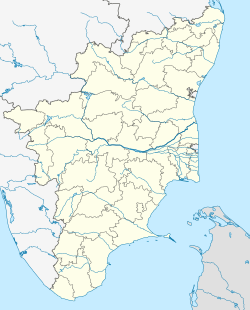world.wikisort.org - India
Keezhadi (Tamil: கீழடி, romanized: kīḻaṭi) is a village near the village of Silaiman, on the border between Madurai and Sivagangai districts, in Tamil Nadu, India. The Keezhadi excavation site is located in this area: excavations carried out by the Archaeological Survey of India (ASI) and the Tamil Nadu Archaeology Department (TNAD) have revealed a Sangam era settlement dated to the 6th century BCE by radiocarbon dating.[1] Claims that the results show that there was writing at that time have been challenged. It is not clear whether the potsherds containing inscriptions were found in the same archaeological layer as the 6th century samples, and University of Calcutta archaeologist Bishnupriya Basak said that "This unfortunately is not clear from the report and is very crucial", adding that the issues of "layer, period and absolute dates" needed clarity. Dravidian University archaeologist E. Harsha Vardhan said that a single report was not enough to "state scientifically that the Tamil-Brahmi script belongs to the sixth century BC".[2]
Keezhadi
கீழடி | |
|---|---|
Village | |
 Archaeological site | |
 Keezhadi Location in Tamil Nadu, India  Keezhadi Keezhadi (Tamil Nadu) | |
| Coordinates: 9.8630727°N 78.1820931°E | |
| Country | India |
| State | Tamil Nadu |
| District | Sivagangai |
| Region | Madurai |
| Government | |
| • Body | Panchayat |
| • President | V Venkatasubramanian |
| Elevation | 123 m (404 ft) |
| Population (2011) | |
| • Total | 5,140 |
| Time zone | UTC+5:30 (IST) |
| PIN | 630611 |
| Telephone code | 04574 |
| Assembly constituency | Manamadurai |
| Lok Sabha constituency | Sivagangai |
Excavations
An archaeological survey team under Archaeologist Amarnath Ramakrishna [3] was first conducted in 2013 in the vicinity of the Vaigai river from Theni district to Ramanathapuram district where the river meets the sea.[4] During the study, 293 sites, including Keezhadi, were identified to have archaeological residues.[5] The first three phases of excavation at Keezhadi were conducted by the Archaeological Survey of India, and they dropped it from doing further research. A public interest litigation was filed and following that the court ordered the regional depart to carry forward, following which the fourth and fifth phases were conducted by the Tamil Nadu Archaeology Department.
Carbon nanomaterials in Keeladi pottery
A team of researchers identified pottery shards at Keeladi that contain carbon nanomaterials, including single-walled and multi-walled carbon nanotubes.[6]
See also
Notes and references
- Dennis S. Jesudasan (20 September 2019). "Keezhadi excavations: Sangam era older than previously thought, finds study". The Hindu.
- Charuch, Sukanya (17 October 2019). "Experts Question Dates of Script in Tamil Nadu's Keeladi Excavation Report". The Wire Science. The Wire (India). Retrieved 12 April 2020.
- The Hindu Net Desk (16 May 2017). "Keezhadi excavation leads to ancient civilisation on the banks of Vaigai". The Hindu.
- Sruthisagar Yamunan (11 May 2017). "Sangam-era site at Keezhadi is as complex as Indus Valley, proof of a glorious Tamil civilisation". Scroll.in.
- The Hindu Net Desk (13 June 2017). "Keezhadi excavation: what was found and what they mean". The Hindu.
- Kokarneswaran, Manivannan; Selvaraj, Prakash; Ashokan, Thennarasan; Perumal, Suresh; Sellappan, Pathikumar; Durai Murugan, Kandhasamy; Ramalingam, Sivanantham; Mohan, Nagaboopathy; Chandrasekaran, Vijayanand (13 November 2020). "Discovery of carbon nanotubes in sixth century BC potteries from Keeladi, India". Scientific Reports. 10 (1): 19786 1–6. Bibcode:2020NatSR..1019786K. doi:10.1038/s41598-020-76720-z. PMC 7666134. PMID 33188244.
6. The New Indian Express (2 Sept 2020) https://www.newindianexpress.com/states/tamil-nadu/2020/sep/02/findings-hint-keezhadi-was-continuously-inhabited-since-sixth-century-bce-2191353.html
Другой контент может иметь иную лицензию. Перед использованием материалов сайта WikiSort.org внимательно изучите правила лицензирования конкретных элементов наполнения сайта.
WikiSort.org - проект по пересортировке и дополнению контента Википедии